Bio-Crafting Architecture: Experiences of Growing Mycelium in Minimal Surface Molds
Abstract
1. Introduction
2. Related Work
2.1. Minimal Surfaces in Architecture
2.2. Mycelium in Architecture
3. Materials and Method
3.1. Creating the Minimal Surfaces
3.2. 3D Printing of Minimal Surfaces
3.3. Mycelium Impregnation, Growth, and Bake
3.4. Public Exhibition
3.5. Participant and Audience Data Collection and Analysis Methods
4. Findings
4.1. Mycelium-Impregnated Bricks
4.2. Designers’ Material Experiences of Working with Mycelium
4.2.1. Mycelium Compared to Non-Living Materials
4.2.2. Ethics and Using Living Materials for Design
4.2.3. Looking into the Future of Architecture and Design
4.3. General Audience Perceptions of Living Materials for Design
4.3.1. Ethics of Working with Living Materials for Design
4.3.2. Perceived Challenges Around Living Materials for Design
4.3.3. Bio-Technological Futures
5. Discussion
6. Conclusions
Author Contributions
Funding
Institutional Review Board Statement
Informed Consent Statement
Data Availability Statement
Acknowledgments
Conflicts of Interest
References
- Commission, E. Construction Sector. Available online: https://single-market-economy.ec.europa.eu/sectors/construction_en (accessed on 2 June 2025).
- Agency, E.E. Building Renovation: Where Circular Economy and Climate Meet. Available online: https://www.eea.europa.eu/publications/building-renovation-where-circular-economy (accessed on 2 June 2025).
- Almpani-Lekka, D.; Pfeiffer, S.; Schmidts, C.; Seo, S.i. A review on architecture with fungal biomaterials: The desired and the feasible. Fungal Biol. Biotechnol. 2021, 8, 17. [Google Scholar] [CrossRef] [PubMed]
- Armstrong, R. Towards the microbial home: An overview of developments in next-generation sustainable architecture. Microb. Biotechnol. 2023, 16, 1112–1130. [Google Scholar] [CrossRef]
- Kniep, J.; Graupner, N.; Reimer, J.J.; Müssig, J. Mycelium-based biomimetic composite structures as a sustainable leather alternative. Mater. Today Commun. 2024, 39, 109100. [Google Scholar] [CrossRef]
- Rajendran, R.C. Packaging Applications of Fungal Mycelium-Based Biodegradable Composites. In Fungal Biopolymers and Biocomposites: Prospects and Avenues; Springer: Berlin/Heidelberg, Germany, 2022; pp. 189–208. [Google Scholar] [CrossRef]
- Pohan, J.; Kusumawati, Y.; Radhitanti, A. Mushroom Mycelium-Based Biodegradable Packaging Material: A Promising Sustainable Solution for Food Industry. In Proceedings of the 5th International Conference of Biospheric Harmony Advanced Research (ICOBAR 2023), Jakarta, Indonesia, 27 June 2023; Volume 426. [Google Scholar] [CrossRef]
- Kırdök, O.; Akyol Altun, D.; Dahy, H.; Strobel, L.; Hameş Tuna, E.; Köktürk, G.; Andiç Çakır, Ö.; Tokuç, A.; Özkaban, F.; Şendemir, A. Design studies and applications of mycelium biocomposites in architecture. In Biomimicry for Materials, Design and Habitats; Eggermont, M., Shyam, V., Hepp, A., Eds.; Elsevier Editora: Sao Paolo, Brazil, 2022; pp. 489–527. [Google Scholar] [CrossRef]
- Stelzer, L.; Hoberg, F.; Bach, V.; Schmidt, B.; Pfeiffer, S.; Meyer, V.; Finkbeiner, M. Life Cycle Assessment of Fungal-Based Composite Bricks. Sustainability 2021, 13, 11573. [Google Scholar] [CrossRef]
- Abdelhady, O.; Spyridonos, E.; Dahy, H. Bio-Modules: Mycelium-Based Composites Forming a Modular Interlocking System through a Computational Design towards Sustainable Architecture. Designs 2023, 7, 20. [Google Scholar] [CrossRef]
- Kontovourkis, O.; Stylianou, S.; Kyriakides, G. An open-source bio-based material system development for sustainable digital fabrication. In Anthropologic: Architecture and Fabrication in the Cognitive Age, Proceedings of the 38th eCAADe Conference, Berlin, Germany, 16–18 September 2020; Werner, L., Koering, D., Eds.; eCAADe (Education and Research in Computer Aided Architectural Design in Europe), Tredition GmbH: Hamburg, Germany, 2020; pp. 31–40. [Google Scholar] [CrossRef]
- Colmo, C.; Ayres, P. Remediating architecture: A bio-hybrid approach employing fungal mycelium. In Structures and Architecture A Viable Urban Perspective? CRC Press: Boca Raton, FL, USA, 2022; pp. 27–34. [Google Scholar] [CrossRef]
- Colmo, C.; Ayres, P. 3D Printed Bio-hybrid Structures—Investigating the architectural potentials of mycoremediation. In Anthropologic: Architecture and Fabrication in the Cognitive Age, Proceedings of the 38th eCAADe Conference, Berlin, Germany, 16–18 September 2020; Werner, L., Koering, D., Eds.; eCAADe (Education and Research in Computer Aided Architectural Design in Europe), Tredition GmbH: Hamburg, Germany, 2020; pp. 573–582. [Google Scholar] [CrossRef]
- Lesna, J.M.; Nicholas, P. De gradus—Programming heterogeneous performance of functionally graded bio-polymers for degradable agricultural shading structures. In RE: Anthropocene, Design in the Age of Humans, Proceedings of the 25th CAADRIA Conference, Bangkok, Thailand, 5–6 August 2020; Association for Computer-Aided Architectural Design Research in Asia: Hong Kong, China, 2020. [Google Scholar] [CrossRef]
- Brandić Lipińska, M.; Maurer, C.; Cadogan, D.; Head, J.; Dade-Robertson, M.; Paulino-Lima, I.G.; Liu, C.; Morrow, R.; Senesky, D.G.; Theodoridou, M.; et al. Biological growth as an alternative approach to on and off-Earth construction. Front. Built Environ. 2022, 8, 965145. [Google Scholar] [CrossRef]
- Attias, N.; Danai, O.; Abitbol, T.; Tarazi, E.; Ezov, N.; Pereman, I.; Grobman, Y.J. Mycelium bio-composites in industrial design and architecture: Comparative review and experimental analysis. J. Clean. Prod. 2020, 246, 119037. [Google Scholar] [CrossRef]
- Butu, A.; Rodino, S.; Miu, B.A.; Butu, M. Mycelium-based Materials for the Ecodesign of Bioeconomy. Dig. J. Nanomater. Biostructures 2020, 15, 1129–1140. [Google Scholar] [CrossRef]
- Ghazvinian, A.; Gursoy, B. Basics of building with mycelium-based bio-composites: A review of Built Projects and Related material research. J. Green Build. 2022, 17, 37–69. [Google Scholar] [CrossRef]
- Özdemir, E.; Rossi, A.; Eversmann, P. MycoCurva: Stay-in-place fabric formworks for curved veneer-reinforced mycelium building components. Archit. Struct. Constr. 2025, 5, 16. [Google Scholar] [CrossRef]
- Rühse, V.; Horvath, A.S. Fungi Matters: A comparison of contemporary fungi imagery between art, design, and architecture. In Proceedings of the Politics of the Machines: Lifelikeness and Beyond 2024, Aachen, Germany, 22–27 April 2024; BCS Learning & Development Ltd.: London, UK, 2025. [Google Scholar] [CrossRef]
- Karana, E.; Barati, B.; Rognoli, V.; van der Laan, A.Z. Material Driven Design (MDD): A Method to Design for Material Experiences. Int. J. Des. 2015, 9, 35–54. Available online: https://www.ijdesign.org/index.php/IJDesign/article/view/1965 (accessed on 2 June 2025).
- Sauerwein, M.; Karana, E.; Rognoli, V. Revived Beauty: Research into Aesthetic Appreciation of Materials to Valorise Materials from Waste. Sustainability 2017, 9, 529. [Google Scholar] [CrossRef]
- Duarte Poblete, S.S.; Romani, A.; Rognoli, V. Emerging materials for transition: A taxonomy proposal from a design perspective. Sustain. Futur. 2024, 7, 100155. [Google Scholar] [CrossRef]
- Walker, M.; Petrovic, E. Naturalness and atypicality of mycelium bio-composites as influencers of preference. In Proceedings of the International Sustainable Ecological Engineering Design for Society (SEEDS) Conference 2022, Bristol, UK, 31 August–2 September 2022; Available online: https://hdl.handle.net/10779/leedsbeckett.28956620.v1 (accessed on 2 June 2025).
- Pérez, J. A New Golden Age of Minimal Surfaces. Not. Am. Math. Soc. 2017, 64, 347–358. [Google Scholar] [CrossRef]
- Schoen, A.H. Infinite periodic minimal surfaces without self-intersections: Three dimensional Euclidean space partitioned into interpenetrating labyrinths by infinite periodic minimal surfaces without self intersections. In NASA Technical Note; National Aeronautics and Space Administration: Washington, DC, USA, 1970. Available online: https://ntrs.nasa.gov/api/citations/19700020472/downloads/19700020472.pdf (accessed on 2 June 2025).
- Horvath, A.S.; Rühse, V.; Raptis, D. SoundSculpt: A Design Framework for 3D Modelling and Digitally Fabricating Sound Patterns. In Proceedings of the OzCHI ’20: 32nd Australian Conference on Human–Computer-Interaction, Sydney, NSW, Australia, 2–4 December 2020; pp. 572–581. [Google Scholar] [CrossRef]
- Gan, Z.; Turner, M.D.; Gu, M. Biomimetic gyroid nanostructures exceeding their natural origins. Sci. Adv. 2016, 2, e1600084. [Google Scholar] [CrossRef]
- Turner, M.D.; Saba, M.; Zhang, Q.; Cumming, B.P.; Schröder-Turk, G.E.; Gu, M. Miniature chiral beamsplitter based on gyroid photonic crystals. Nat. Photonics 2013, 7, 801–805. [Google Scholar] [CrossRef]
- Schlaich Bergermann, P. Roof for Munich Olympic Stadium 1972. 2025. Available online: https://www.sbp.de/en/project/roof-for-munich-olympic-stadium-1972/ (accessed on 2 June 2025).
- TheVeryMany, M.F. Minima|Maxima WORLD EXPO PAVILION. 2017. Available online: https://theverymany.com/world-expo-17-astana-kz-1 (accessed on 2 June 2025).
- TheVeryMany, M.F. The Orb|Google—CHARLESTON EAST CAMPUS—Plaza ANCHORING ARTWORK. 2023. Available online: https://theverymany.com/google (accessed on 2 June 2025).
- Colabella, S.; Pugnale, A.; Halls, J.; Park, M.M.; Mangliár, L.; Hudert, M. Making the Hypar Up pavilion: (in)efficiencies of upcycling surplus timber products. Archit. Intell. 2024, 3, 31. [Google Scholar] [CrossRef]
- Țenu, V. Vlad Tenu—Work. 2025. Available online: https://www.vladtenu.com/news (accessed on 2 June 2025).
- García-Gascón, C.; Castelló-Pedrero, P.; García-Manrique, J.A. Minimal Surfaces as an Innovative Solution for the Design of an Additive Manufactured Solar-Powered Unmanned Aerial Vehicle (UAV). Drones 2022, 6, 285. [Google Scholar] [CrossRef]
- Merritt, T.; Hamidi, F.; Alistar, M.; DeMenezes, M. Living media interfaces: A multi-perspective analysis of biological materials for interaction. Digit. Creat. 2020, 31, 1–21. [Google Scholar] [CrossRef]
- Sheldrake, M. Entangled Life: How Fungi Make Our Worlds; Random House: New York, NY, USA, 2020. [Google Scholar]
- Ecovative. 2025. Available online: https://ecovative.com/ (accessed on 2 June 2025).
- Kineco. 2025. Available online: https://www.kineco.bio/ (accessed on 2 June 2025).
- Superflux. Mycotecture (Phil Ross). 2009. Available online: https://www.moma.org/interactives/exhibitions/2013/designandviolence/mycotecture-phil-ross/ (accessed on 2 June 2025).
- Vandelook, S.; Elsacker, E.; Van Wylick, A.; De Laet, L.; Peeters, E. Current state and future prospects of pure mycelium materials. Fungal Biol. Biotechnol. 2021, 8, 20. [Google Scholar] [CrossRef] [PubMed]
- Abhijith, R.; Ashok, A.; Rejeesh, C. Sustainable packaging applications from mycelium to substitute polystyrene: A review. Mater. Today Proc. 2018, 5, 2139–2145. [Google Scholar] [CrossRef]
- McGaw, J.; Andrianopoulos, A.; Liuti, A. Tangled Tales of Mycelium and Architecture: Learning From Failure. Front. Built Environ. 2022, 8, 805292. [Google Scholar] [CrossRef]
- Nguyen, M.T.; Solueva, D.; Spyridonos, E.; Dahy, H. Mycomerge: Fabrication of Mycelium-Based Natural Fiber Reinforced Composites on a Rattan Framework. Biomimetics 2022, 7, 42. [Google Scholar] [CrossRef]
- Ghazvinian, A.; Khalilbeigi, A.; Mottaghi, E.; Gürsoy, B. The Design And Fabrication Of Mycocreate 2.0: A Spatial Structure Built With Load-Bearing Mycelium-Based Composite Components. J. Int. Assoc. Shell Spat. Struct. 2022, 63, 85–97. [Google Scholar] [CrossRef]
- Goidea, A.; Floudas, D.; Andréen, D. Pulp Faction: 3d printed material assemblies through microbial biotransformation. In Fabricate 2020; UCL Press: London, UK, 2020; pp. 42–49. [Google Scholar]
- Tan, Y.Y.; Chia, P.Z.; Quek, Y.H.; Tracy, K.J.; Yogiaman, C. Multimaterial Knit Skins: A Design-to-Fabrication Workflow for Mass Customized Freeform Membrane Panels. Technol.|Archit. + Des. 2022, 6, 184–199. [Google Scholar] [CrossRef]
- Özdemir, E.; Saeidi, N.; Javadian, A.; Rossi, A.; Nolte, N.; Ren, S.; Dwan, A.; Acosta, I.; Hebel, D.E.; Wurm, J.; et al. Wood-veneer-reinforced mycelium composites for sustainable building components. Biomimetics 2022, 7, 39. [Google Scholar] [CrossRef] [PubMed]
- Alima, N.; Snooks, R.; McCormack, J. Bio Scaffolds: The orchestration of biological growth through robotic intervention. Int. J. Intell. Robot. Appl. 2022, 6, 522–529. [Google Scholar] [CrossRef]
- Ghazvinian, A.; Farrokhsiar, P.; Vieira, F.; Pecchia, J.; Gursoy, B. Study on the Sound Absorption Properties of Mycelium-Based Composites Cultivated on Waste Paper-Based Substrates. In Proceedings of the 37 eCAADe and XXIII SIGraDi Joint Conference, “Architecture in the Age of the 4Th Industrial Revolution”, Porto, Portugal, 11–13 September 2019; pp. 505–514. [Google Scholar] [CrossRef]
- Elsacker, E.; Peeters, E.; De Laet, L. Mycelium-based materials at the dawn of the Anthropocene. In Structures and Architecture-Bridging the Gap and Crossing Borders; CRC Press: Boca Raton, FL, USA, 2019; pp. 1083–1090. [Google Scholar]
- Wagner, M. Das Material der Kunst. Eine andere Geschichte der Moderne; C.H. Beck Verlag: Munich, Germany, 2002. [Google Scholar]
- Giaccardi, E.; Karana, E. Foundations of Materials Experience: An Approach for HCI. In Proceedings of the CHI ’15: 33rd Annual ACM Conference on Human Factors in Computing Systems, Seoul, Republic of Korea, 18–23 April 2015; pp. 2447–2456. [Google Scholar] [CrossRef]
- Karana, E.; Pedgley, O.; Rognoli, V. On Materials Experience. Des. Issues 2015, 31, 16–27. [Google Scholar] [CrossRef]
- Pedgley, O.; Rognoli, V.; Karana, E. Materials experience as a foundation for materials and design education. Int. J. Technol. Des. Educ. 2016, 26, 613–630. [Google Scholar] [CrossRef]
- Schmidt, K. Chromodoris. Available online: https://www.food4rhino.com/en/app/chromodoris (accessed on 2 June 2025).
- Fillamentum. Timberfill. 2025. Available online: https://fillamentum.com/wp-content/uploads/2020/10/Technical-Data-Sheet_Timberfill_03012019.pdf (accessed on 2 June 2025).
- Naeem, M.; Ozuem, W.; Howell, K.; Ranfagni, S. A Step-by-Step Process of Thematic Analysis to Develop a Conceptual Model in Qualitative Research. Int. J. Qual. Methods 2023, 22, 16094069231205789. [Google Scholar] [CrossRef]
- Lazar, J.; Feng, J.H.; Hochheiser, H. Research Methods in Human–Computer Interaction; Wiley Publishing: West Sussex, UK, 2010. [Google Scholar]
- Holtzblatt, K.; Beyer, H. Contextual Design: Defining Customer-Centered Systems; Morgan Kaufmann: San Diego, CA, USA, 1998. [Google Scholar]
- Cigánik, O.; Vele, J.; Roth, M.; Sỳsová, K. Mycelium in Architectural Education: Digital Fabrication Reconsidered. In Proceedings of the 9th eCAADe Regional International Symposium, Tallinn, Estonia, 16 June 2023; pp. 169–174. [Google Scholar]
- Appels, F.V.; Camere, S.; Montalti, M.; Karana, E.; Jansen, K.M.; Dijksterhuis, J.; Krijgsheld, P.; Wösten, H.A. Fabrication factors influencing mechanical, moisture-and water-related properties of mycelium-based composites. Mater. Des. 2019, 161, 64–71. [Google Scholar] [CrossRef]
- Aiduang, W.; Chanthaluck, A.; Kumla, J.; Jatuwong, K.; Srinuanpan, S.; Waroonkun, T.; Oranratmanee, R.; Lumyong, S.; Suwannarach, N. Amazing fungi for eco-friendly composite materials: A comprehensive review. J. Fungi 2022, 8, 842. [Google Scholar] [CrossRef] [PubMed]
- Karana, E.; Blauwhoff, D.; Hultink, E.J.; Camere, S. When the Material Grows: A Case Study on Designing (with) Mycelium-based Materials. Int. J. Des. 2018, 12, 119–136. Available online: https://www.ijdesign.org/index.php/IJDesign/article/view/2918 (accessed on 2 June 2025).
- Lim, A.; Thomsen, M.R. Multi-Material Fabrication for Biodegradable Structures—Enabling the Printing of Porous Mycelium Composite Structures. In Proceedings of the eCAADe 2021: Towards a New, Configurable Architecture, Novi Sad, Serbia, 8–10 September 2021. [Google Scholar] [CrossRef]
- Tamke, M.; Lafuente Hernández, E.; Deleuran, A.; Gengnagel, C.; Burry, M.; Ramsgaard Thomsen, M. A new Material Practice: Integrating Design and Material Behavior. In SimAUD 2012, 1st ed.; Nikolovska, L., Attar, R., Eds.; Society for Computer Simulation International: San Diego, CA, USA, 2012; pp. 5–12. [Google Scholar]
- Wilson, E.O. Biophilia: The Human Bond with Other Species; Harvard University Press: Cambridge, MA, USA, 1986. [Google Scholar]
- Stephen, R.; Kellert Judith, H.; Heerwagen, M.L.M. Biophilic Design: The Theory, Science and Practice of Bringing Buildings to Life; John Wiley&Sons: Hoboken, NJ, USA, 2008. [Google Scholar]
- Soga, M.; Gaston, K.J.; Fukano, Y.; Evans, M.J. The vicious cycle of biophobia. Trends Ecol. Evol. 2023, 38, 512–520. [Google Scholar] [CrossRef]
- Soga, M.; Evans, M.J. Biophobia: What it is, how it works and why it matters. People Nat. 2024, 6, 922–931. [Google Scholar] [CrossRef]
- Barragan-Jason, G.; de Mazancourt, C.; Parmesan, C.; Singer, M.C.; Loreau, M. Human–nature connectedness as a pathway to sustainability: A global meta-analysis. Conserv. Lett. 2022, 15, e12852. [Google Scholar] [CrossRef]
- d´Eaubonne, F. Feminism or Death—How the Women’s Movement Can Save the Planet; Verso Books: New York, NY, USA, 2022. [Google Scholar]
- Horvath, A.S.; Löchtefeld, M.; Heinrich, F.; Bemman, B. STEAM Matters for Sustainability: 10 years of Art and Technology student research on sustainability through Problem-based Learning. J. Probl. Based Learn. High. Educ. 2023, 11, 1–33. [Google Scholar] [CrossRef]
- Olsen, C.S. From architectures of capital to architectures of care: The arts of dreaming otherwise in the Oslo Architecture Triennale. In Haste: The Slow Politics of Climate Urgency; UCL Press: London, UK, 2023; pp. 27–37. [Google Scholar]
- Kagan, S. Artful Sustainability: Queer-Convivialist Life-Art and the Artistic Turn in Sustainability Research. Transdiscipl. J. Eng. Sci. 2017, 8, 51–168. [Google Scholar] [CrossRef]
- Bentz, J. Learning about climate change in, with and through art. Clim. Change 2020, 162, 1595–1612. [Google Scholar] [CrossRef]
- Bellacasa, M.P.D.L. Matters of Care: Speculative Ethics in More than Human Worlds; University of Minnesota Press: Minneapolis, MN, USA, 2017; Available online: http://www.jstor.org/stable/10.5749/j.ctt1mmfspt (accessed on 2 June 2025).
- Cotsaftis, O.; Williams, N.; Chyon, G.; Sadar, J.; Va Pesaran, D.M.; Wines, S.; Naarden, S. Designing conditions for coexistence. Des. Stud. 2023, 87, 101199. [Google Scholar] [CrossRef]
- Wakkary, R. Things We Could Design: For More Than Human-Centered Worlds; The MIT Press: Cambridge, MA, USA, 2021. [Google Scholar] [CrossRef]
- Horvath, A.S.; Jochum, E.; Löchtefeld, M.; Vissonova, K.; Merritt, T. Soft Robotics Workshops: Supporting Experiential Learning About Design, Movement, and Sustainability. In Cultural Robotics; Dunstan, B., Koh, J., Turnbull Tillman, D., Brown, S., Eds.; Springer Series on Cultural Computing; Springer: Berlin/Heidelberg, Germany, 2023; pp. 189–218. [Google Scholar] [CrossRef]
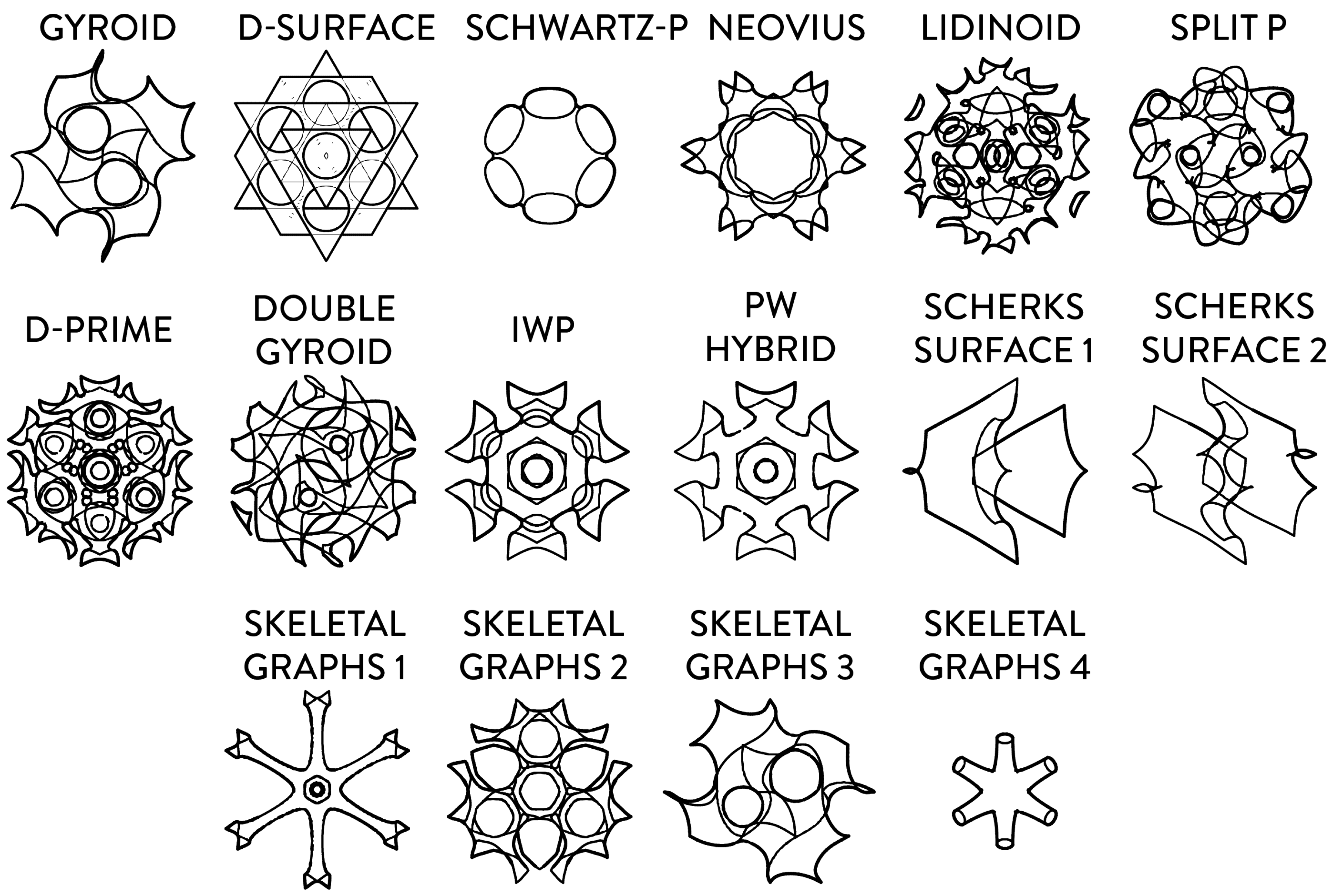

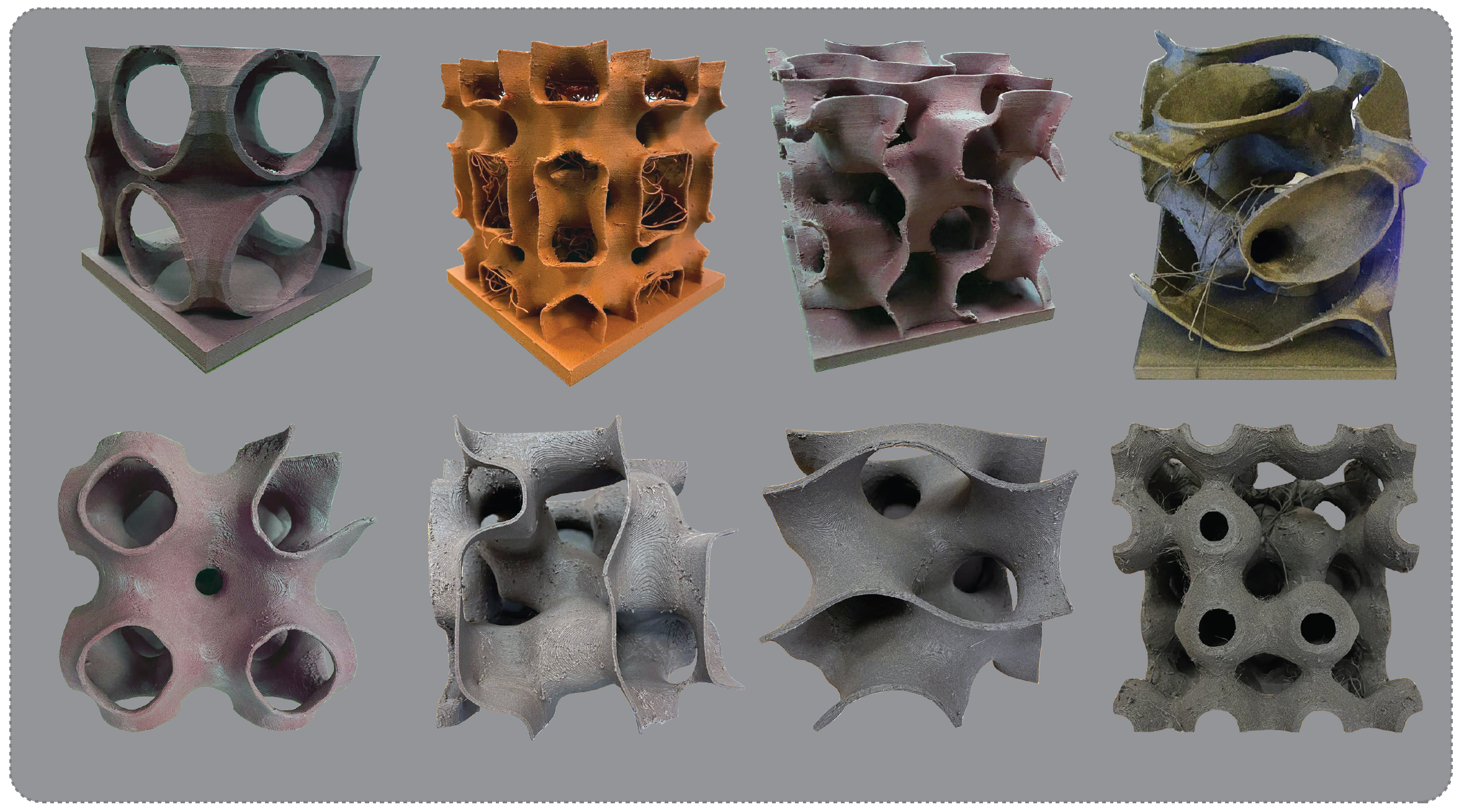
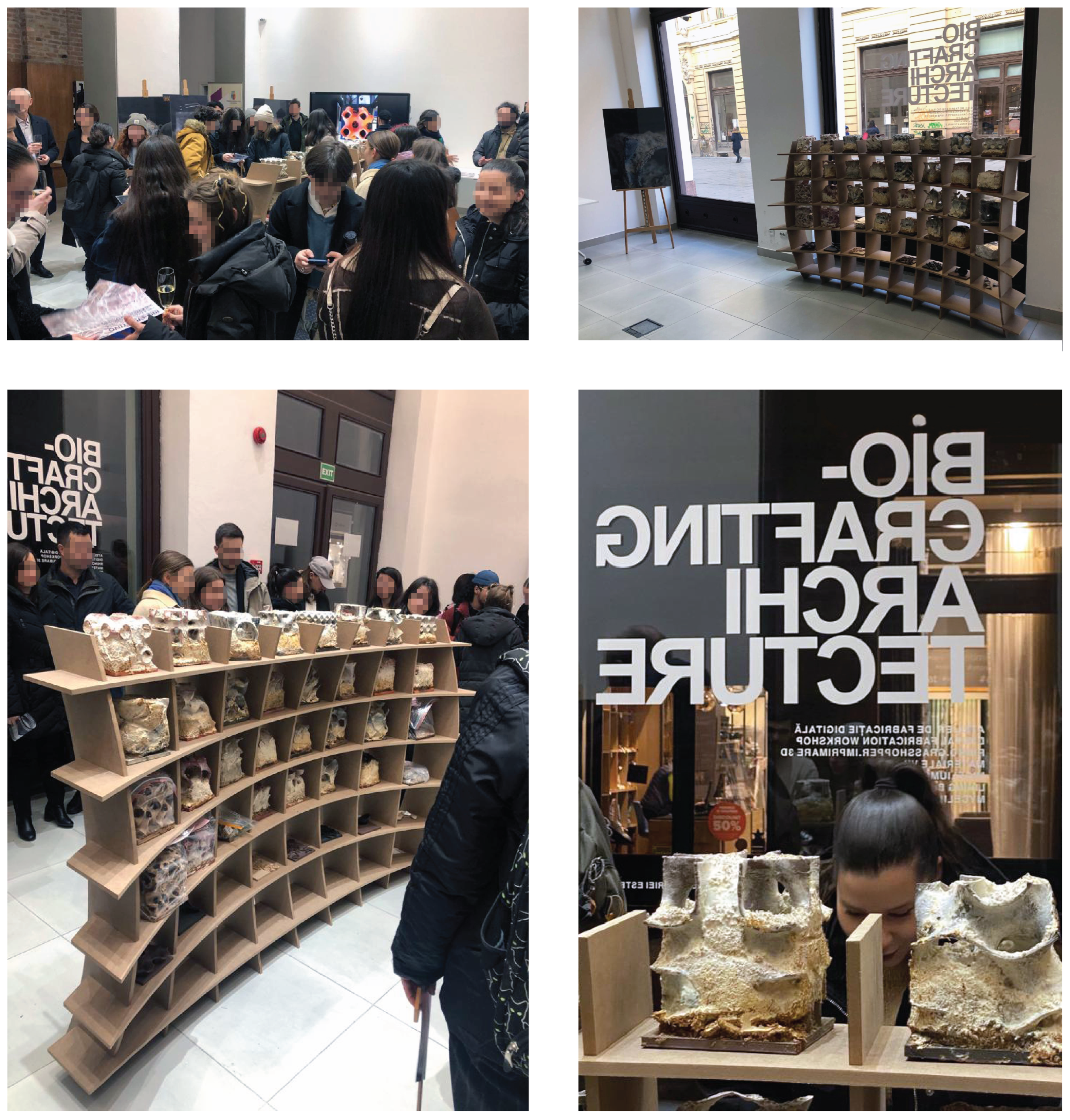

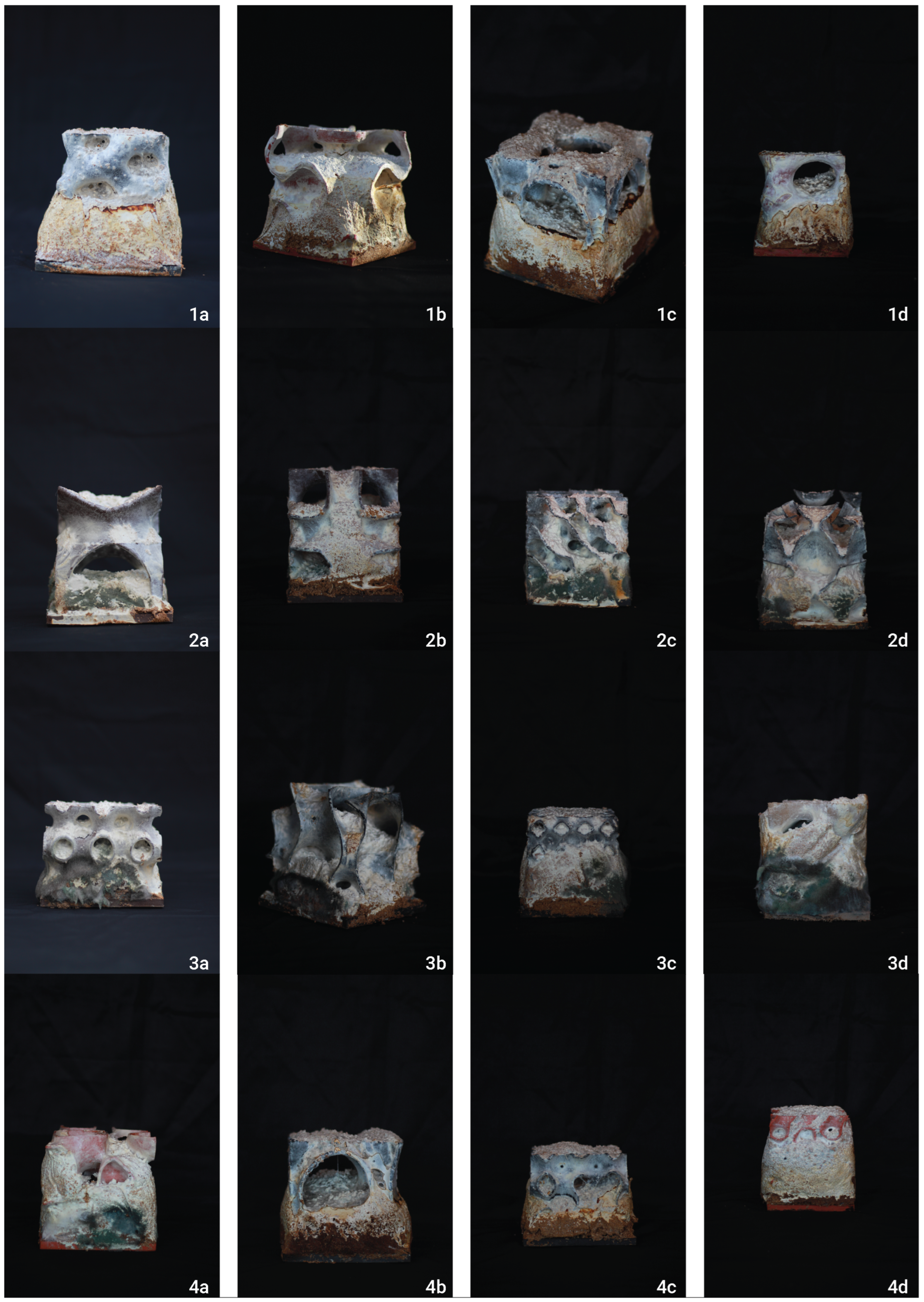
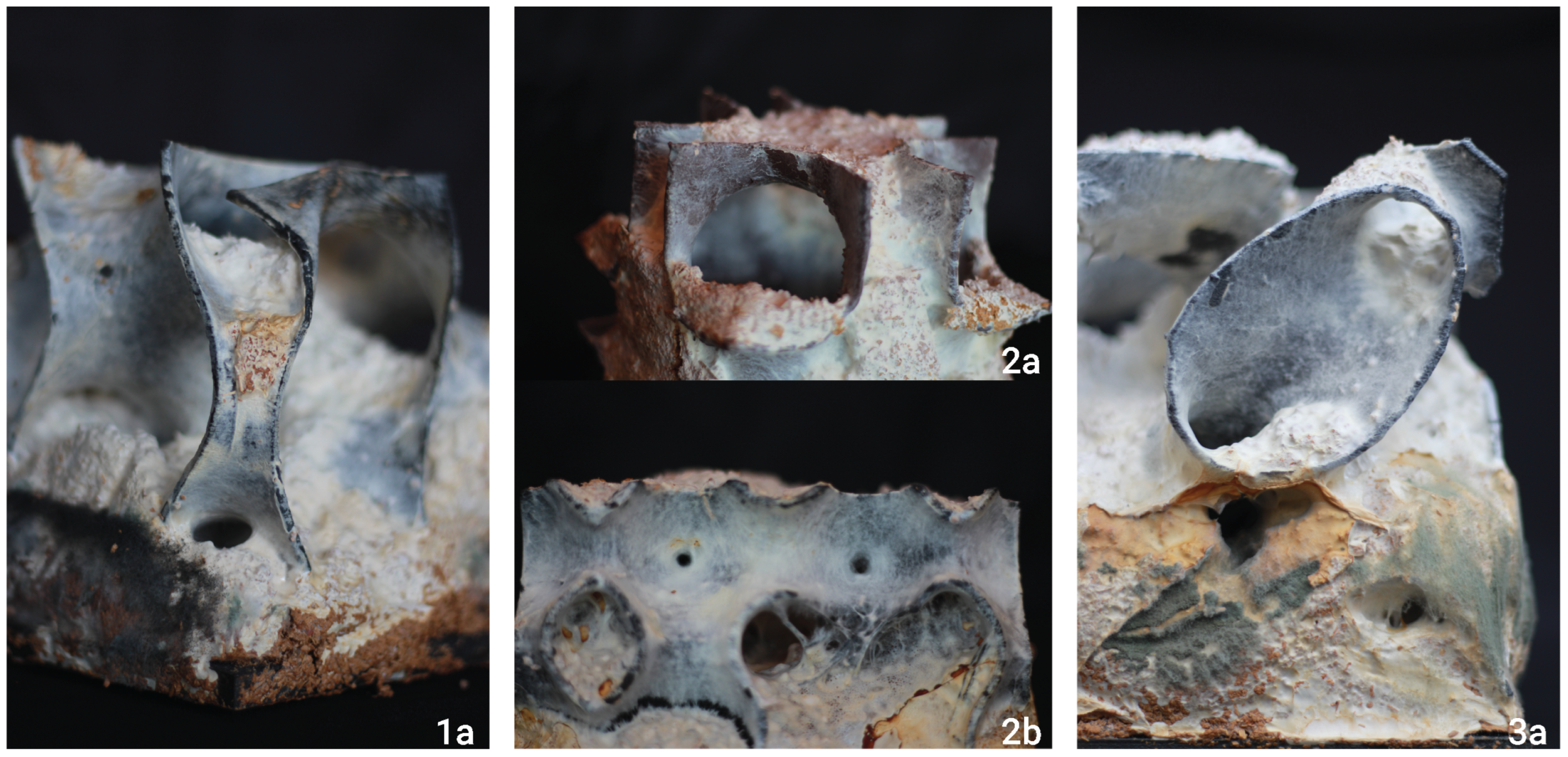



Disclaimer/Publisher’s Note: The statements, opinions and data contained in all publications are solely those of the individual author(s) and contributor(s) and not of MDPI and/or the editor(s). MDPI and/or the editor(s) disclaim responsibility for any injury to people or property resulting from any ideas, methods, instructions or products referred to in the content. |
© 2025 by the authors. Licensee MDPI, Basel, Switzerland. This article is an open access article distributed under the terms and conditions of the Creative Commons Attribution (CC BY) license (https://creativecommons.org/licenses/by/4.0/).
Share and Cite
Horvath, A.-S.; Voinea, A.E.; Arieșan, R.A. Bio-Crafting Architecture: Experiences of Growing Mycelium in Minimal Surface Molds. Sustainability 2025, 17, 6835. https://doi.org/10.3390/su17156835
Horvath A-S, Voinea AE, Arieșan RA. Bio-Crafting Architecture: Experiences of Growing Mycelium in Minimal Surface Molds. Sustainability. 2025; 17(15):6835. https://doi.org/10.3390/su17156835
Chicago/Turabian StyleHorvath, Anca-Simona, Alina Elena Voinea, and Radu Adrian Arieșan. 2025. "Bio-Crafting Architecture: Experiences of Growing Mycelium in Minimal Surface Molds" Sustainability 17, no. 15: 6835. https://doi.org/10.3390/su17156835
APA StyleHorvath, A.-S., Voinea, A. E., & Arieșan, R. A. (2025). Bio-Crafting Architecture: Experiences of Growing Mycelium in Minimal Surface Molds. Sustainability, 17(15), 6835. https://doi.org/10.3390/su17156835





